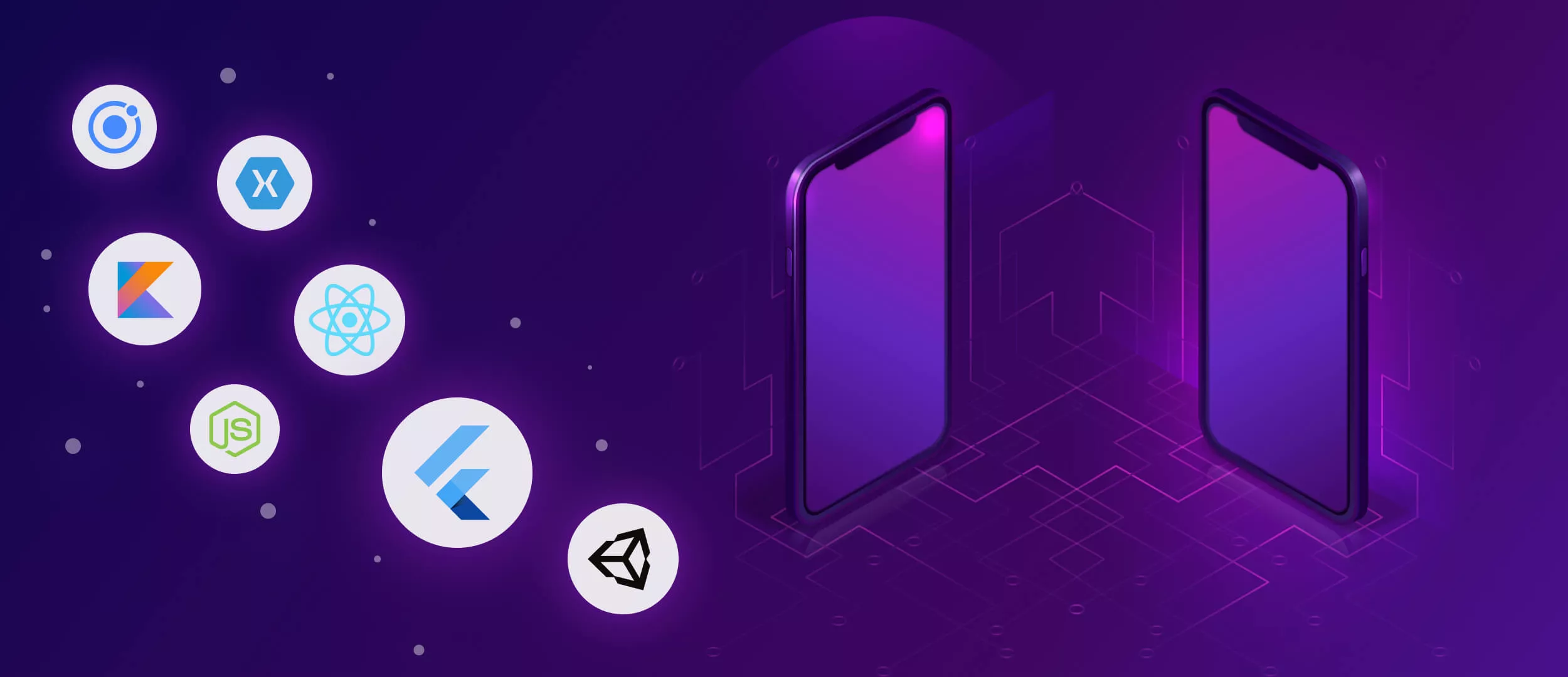Top 7 Best Cross-Platform App Development Frameworks in 2023

Developers around the world choose cross-platform application development because of the benefits it offers. Today there are a huge number of frameworks that allow developers to use the same repetitive code to create applications designed for different platforms. If you want to choose the best cross-platform application development framework for your project, you are in the right place. In this blog post, we'll take a look at the leading frameworks currently available that will allow you to achieve your development goals.
What Is a Cross-Platform App Development Framework?
Frameworks are special programs consisting of a set of tools and libraries that help developers create applications much faster and more efficiently. However, many of these frameworks are designed to develop Android and iOS cross-platform apps.
Cross-platform frameworks bring added value to application development by providing the tools to build cross-platform mobile apps at once. With the help of such frameworks, a developer can create a single code to run Web applications, iOS, and Android operating systems. Thus, many developers choose cross-platform frameworks because they open up new possibilities in application development.
Ivanna
Client Manager
Benefits of Cross-Platform App Development
The benefits of cross-platform development include development speed and development cost. Let's talk about the advantages of using the Flutter framework as an example:
- Cross-platform development is faster and more cost-effective. Experience has shown that the time saving for application development is up to 40% compared to the native;
- Flutter allows you to quickly enter the market with an end or minimum-viable product;
- high code quality due to detailed code review (checking the code for errors and incorrect architectural decisions). Since the Flutter programming team works with a single code base, all members are as immersed and understand the project as possible;
- fairly simple scaling of in-house development and through contractors;
- unlimited in creating the functionality and interface of the application;
- low costs for bug fixes and updates;
- every developer can get acquainted with the source code of Flutter and even contribute to its development;
- Flutter has only one layer written in C/C++, which makes it very close to native performance.
Best Cross-Platform App Development Frameworks
In this part of the blog post, we will look through the most in-demand Cross-Platform App Development Frameworks
Ionic
Overview
This is a Hybrid-Web framework where mobile applications run in a special shell (UIWebView for iOS and WebView for Android), which already allows you to show HTML and execute JavaScript. It turns out that the application works as if in a web browser :)
There is no need for deep knowledge in any of the frameworks. Ionic has a huge built-in library of common tools and a large number of plugins and modules that provide access to native functionality.
Pros
- The well-known toolkit is used.
- Development on the Ionic framework is much faster than on the rest. It is based on Angular, which means that during development, the application can be run in a browser and see how it looks.
- There are ready-made application templates and built-in presets, so getting started is a breeze.
- Concept: "Create once, use always and everywhere."
- Several user interface components are available.
Cons
- according to developers, testing an application can be quite difficult. You can't test built-in device features (e.g. camera, blink) that are in the Ionic documentation, because these functions simply cannot be performed in a browser;
- various native "chips" are difficult to combine;
- running Ionic apps will work poorly on older Android devices: to run an Ionic app will use the device's default browser. Devices with older versions of Android (4.0-4.3) use the Android browser by default, not Chrome;
- if the project has complex graphics, then Ionic won’t work.
Apps Built with Ionic
- Sanvello
- MarketWatch
- JustWatch
- Sworkit
- Untappd
Xamarin
Overview
A relatively new cross-platform Hybrid-Native framework based on the principles of the Microsoft Foundations. Compatible with absolutely any OS. Xamarin makes it possible to create applications that are almost indistinguishable from their native counterparts.
The framework consists of several main parts:
- Xamarin. iOS - class library for C # with access to the iOS SDK);
- Xamarin. Android is a class library for C# with access to the Android SDK;
- compilers for iOS and Android;
- Environments: Xamarin Studio IDE or Visual Studio.
Pros
- A universal set of technologies for development on all platforms.
- The performance is as close as possible to that of native applications.
- Good compatibility with devices and optimal testing conditions (at least for the test, you can use Xamarin UI Tests - using this framework, you can write your autotests in C # and run them both locally and in the App Center Test Cloud).
- Excellent compatibility with IoT (Internet of Things) devices and seamless integration with Microsoft Windows.
- Open source technologies and complete toolkit.
Cons
- delays in platform updates;
- limited ecosystem;
- limited access to open-source libraries: all that remains is to use the components provided by the platform and some .NET resources;
- not suitable for applications with high-performance graphics;
- usually, applications on Xamarin weigh 2 times more than native ones;
- you may need some feature or integration in the application, and it is not provided by the platform.
Apps Built with Xamarin
- Fox Sports
- Alaska Airlines
- HCL
- American Cancer Society
- BBC Good Food
React Native
Overview
It is used to translate the application code into machine language and provides a native look and feels for mobile applications.
When working with React Native, you need to build your controls, build a hierarchy with integration in mind, and design the user interface in React Native.
Pros
- Cross-platform. The application will work on all platforms: almost all code is written in JavaScript, a common language for all platforms, and this code interacts with native OS components. But keep in mind that, for example, bringing the application in line with the formal requirements of different operating systems will have to be done separately.
- Simplicity and ease of creation. The cross-platform React Native framework is quite simple and convenient (of course, if the developer understands what he is doing and what he wants to get in the end).
- Saving time. Cross-platform, open-source plugins and ease of development all make things easier and save time.
- React Native is perfect if you need the speed of a native app but don't need complexity.
Cons
- this is a young framework and some components are missing, and there are too many updates, and this threatens that you will constantly have to follow the latest versions of the framework and its libraries,
- not suitable for a project with heavy and complex graphics and animation, and if you need it, you may have to tinker with the native code,
- there is no visual interface editor and everything is done in code using JSX markup (not that it is required, but at least you can see the component hierarchy this way).
Apps Built with React Native
- Bloomberg
- Skype
- Tesla
Flutter
Overview
Allows you to develop mobile apps for multiple platforms in the Dart language. Flutter offers many UI elements that look native to the OS but aren't. This framework may be suitable for creating a unified UX, and it takes a different approach than React Native.
Flutter doesn’t turn source code into native code that is executed by the platform. It draws a window on the mobile screen and displays all the elements themselves.
Pros
- Dart Language. Initially conceived as a tool for developing client applications, it has been optimized and created for user interface development. This language provides excellent opportunities for developing cross-platform mobile applications. Also, Dart was created by Google as an extended version of JavaScript.
- Mass transition to Flutter. It only took Flutter a year to surpass React Native in popularity (although React Native was the most in-demand platform at the time). Today, with Flutter, you get a powerful source of learning resources and more qualified developers to build your app.
- Widgets. Flutter provides a set of widgets in Google’s Material Design and in Apple’s style with the Cupertino pack
Cons
- Raw API. They can change the specification on the fly.
- There are still glitches in text fields on some phone models (the text is doubled).
- There is no normal WYSIWYG editor.
Apps Built with Flutter
- Alibaba
- Google Ads
- Tencent
Node.js
Overview
Node.js is a framework for Android and iOS that makes JavaScript a general-purpose language. To put it simply, this tool adds a back-end part to a fully front-end language, allowing you to create with it not only websites but also full-fledged applications, without using a browser.
Pros
- General code. There is not much code used both on the client and the server side, but it is present. The main thing is to understand that often objects with the same names can perform completely different functions in the browser and on the backend. Speed. It doesn't take long to create a working prototype that can handle the load.
- Large and vibrant community. Since the code is open, web developers can write different modules and packages and share them. Often, the modules are well combined.
- JavaScript syntax. Yes, you will have to learn new instruments, but there will be a lot of familiar ones. This ensures relative simplicity and accessibility.
- Built-in library. With each update, it expands, but even in the first version, there were quite a lot of opportunities.
- The constant development of the ecosystem. The number of ready-made modules and external libraries is constantly growing, which is facilitated by the use of npm.
- V8 engine. It consumes memory economically, is well-optimized, and provides functionality for profiling the processor and memory.
- The popularity and benefits of Node js have not gone unnoticed, and companies such as Google, eBay/PayPal, Netflix, Microsoft, Uber, Linkedin, Yahoo, Walmart, and others have already chosen it.
Cons
- Poor performance when working with heavy computing tasks Keeping several tasks in the queue can greatly complicate the program, making it difficult to understand the code.
- While the core modules of Node.js are fairly stable and can be considered mature, many tools in the npm registry are either of poor quality or lack clear documentation and have not been properly tested.
Apps Built with Node.js
- Paypal
- eBay
- Shutterstock
- Walmart
Kotlin Multiplatform Mobile
Overview
As of 2020, Kotlin has remained the main language of Android development. According to Google, 70% of the top 1000 apps on Google Play were written in Kotlin. The clean and clear syntax of Kotlin allows developers to write mobile applications faster than in Java.
Pros
- Less development time without losing the benefits of native technologies
- Maximum performance
- In native solutions written in Kotlin Multiplatform, it is usually easier to access smartphone features such as camera, microphone, and offline mode.
Cons
- Kotlin Multiplatform allows developers to reuse code for multiple operating systems rather than writing one codebase for all target platforms.
- Debugging native code becomes more difficult when Kotlin is used for cross-platform development.
Apps Built with Kotlin Multiplatform
- PlanGrid.
- Memrise.
- Cash App.
- Netflix.
Unity
Overview
Unity is a multi-platform tool for developing 2D and 3D applications and games, and also one of the best tools for demonstrating 3D content. Applications created with Unity run on Windows, OS X, Linux, Android, Apple iOS, Windows Phone, and BlackBerry operating systems, as well as on Wii, PlayStation 3, and Xbox 360 game consoles.
Pros
- A great option for creating mobile games for a range of devices
- The 3D engine gives high-quality results without any complicated configurations.
- There are a lot of free plugins.
- Unity allows the developer to make their shaders and change the way Unity renders the game.
Cons
- UI and difficulty to use for beginners
- Source code not available
- Compilers are not supported for ARM processors on some versions of mobile gadgets.
Apps Built with Unity
- Shapes
- Golf Club: Wasteland.
- Nano Simbox
- Kavtek
- Trinity. UNLTD.
How to Choose the Right Cross-platform App Development Framework?
There are many cross-platform frameworks and new services will continue to appear on the market. But what to choose for your project? First, you need to understand your project's goals and requirements.
1. The expertise of developers
Options for developing multi-platform mobile app frameworks based on various programming languages. Before using a framework, check what skills it requires and ensure that your team has enough experience. If your team has expertise with JavaScript, choose React Native.
2. Vendor support
You must ensure that the vendor of the framework will support it for a long period.
3. UI customization
The user interface is crucial for your future app, you need to know how to customize the UI using a specific framework.
4. Framework capabilities
Every framework has its limitations and capabilities. You have to know what tools and features a framework provides - that is important for your project. For example, how quickly and simply you will be able to develop, debug, and test your app?
5. Security
Privacy and security are very important when creating a mobile app for business, for example, an eCommerce app that includes a payment system.
How Can Stfalcon Help You in Cross-Platform Development?
Most companies start their online business by creating a website. In the future, the resource is adapted to work with mobile devices, and with positive traffic dynamics, a decision is made to create an application for Android and iOS.
An application for mobile devices is more functional than a website, it has a user-friendly interface and the ability to work even without an Internet connection (with limited functionality). The absolute dominance of two operating systems has formed in the mobile market. These are iOS and Android. When creating mobile applications for these and other operating systems, the focus is on the following issues:
- High development speed
- Reliability, stability in work
- Ease of support and release of updates
- Making the most of the platform's capabilities
Depending on the target audience and goals, the development of mobile applications for iOS and Android is carried out using native or cross-platform technologies. In our company, you can order both native and cross-platform development.
Conclusion
Developing applications for Android and iOS, if you create a separate solution for each operating system, increase the time and cost of the project. This situation has led to the emergence of cross-platform mobile apps.
The multi-platform app development uses the fact that the creation of mobile applications for Android and iOS is carried out in markup languages and styles. These are the JavaScript, CSS, and HTML used to create websites. This approach is justified since in the end most of the content is presented in the form of HTML pages. Applications of this type are written and are suitable for almost all existing devices since they are based on the browser mechanism. So the best is to choose cross-platform mobile development, if you interested just contact us.



